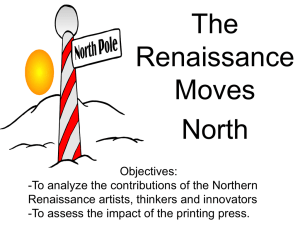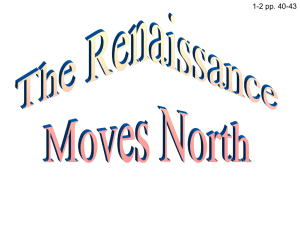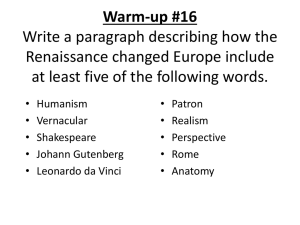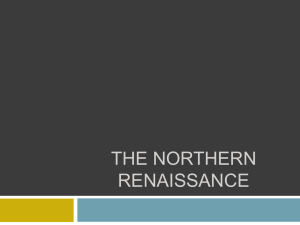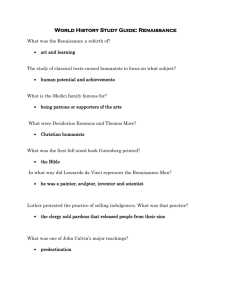The Renaissance in the North
advertisement
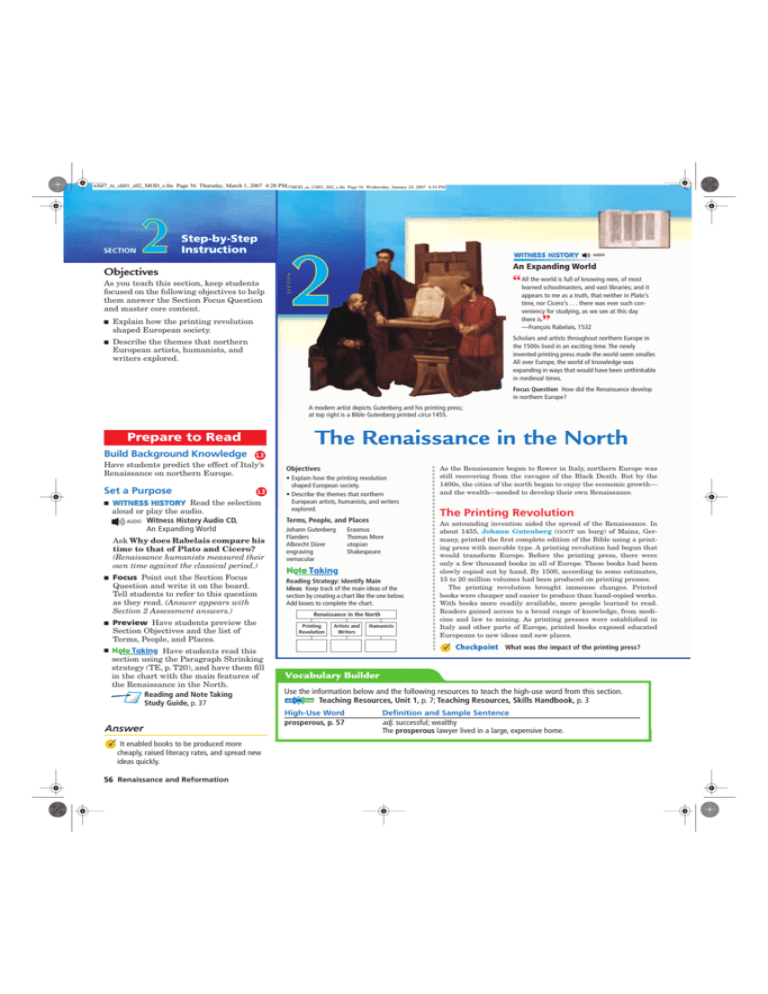
wh07_te_ch01_s02_MOD_s.fm Page 56 Thursday, March 1, 2007 4:28 WH07MOD_se_CH01_S02_s.fm PM SECTION 2 Step-by-Step Instruction Objectives As you teach this section, keep students focused on the following objectives to help them answer the Section Focus Question and master core content. ■ Explain how the printing revolution shaped European society. ■ Describe the themes that northern European artists, humanists, and writers explored. Page 56 Wednesday, January 24, 2007 4:34 PM WITNESS HISTORY 2 AUDIO An Expanding World the world is full of knowing men, of most “ Alllearned schoolmasters, and vast libraries; and it appears to me as a truth, that neither in Plato’s time, nor Cicero’s . . . there was ever such conveniency for studying, as we see at this day there is. —François Rabelais, 1532 ” Scholars and artists throughout northern Europe in the 1500s lived in an exciting time. The newly invented printing press made the world seem smaller. All over Europe, the world of knowledge was expanding in ways that would have been unthinkable in medieval times. Focus Question How did the Renaissance develop in northern Europe? A modern artist depicts Gutenberg and his printing press; at top right is a Bible Gutenberg printed circa 1455. The Renaissance in the North Prepare to Read Build Background Knowledge L3 Have students predict the effect of Italy’s Renaissance on northern Europe. Set a Purpose ■ L3 WITNESS HISTORY Read the selection aloud or play the audio. AUDIO Witness History Audio CD, An Expanding World Ask Why does Rabelais compare his time to that of Plato and Cicero? (Renaissance humanists measured their own time against the classical period.) ■ Focus Point out the Section Focus Question and write it on the board. Tell students to refer to this question as they read. (Answer appears with Section 2 Assessment answers.) ■ Preview Have students preview the Section Objectives and the list of Terms, People, and Places. ■ Have students read this section using the Paragraph Shrinking strategy (TE, p. T20), and have them fill in the chart with the main features of the Renaissance in the North. Reading and Note Taking Study Guide, p. 37 Answer It enabled books to be produced more cheaply, raised literacy rates, and spread new ideas quickly. 56 Renaissance and Reformation Objectives • Explain how the printing revolution shaped European society. • Describe the themes that northern European artists, humanists, and writers explored. Terms, People, and Places Johann Gutenberg Flanders Albrecht Dürer engraving vernacular Erasmus Thomas More utopian Shakespeare Reading Strategy: Identify Main Ideas Keep track of the main ideas of the section by creating a chart like the one below. Add boxes to complete the chart. Renaissance in the North Printing Revolution Artists and Writers Humanists As the Renaissance began to flower in Italy, northern Europe was still recovering from the ravages of the Black Death. But by the 1400s, the cities of the north began to enjoy the economic growth— and the wealth—needed to develop their own Renaissance. The Printing Revolution An astounding invention aided the spread of the Renaissance. In about 1455, Johann Gutenberg (GOOT un burg) of Mainz, Germany, printed the first complete edition of the Bible using a printing press with movable type. A printing revolution had begun that would transform Europe. Before the printing press, there were only a few thousand books in all of Europe. These books had been slowly copied out by hand. By 1500, according to some estimates, 15 to 20 million volumes had been produced on printing presses. The printing revolution brought immense changes. Printed books were cheaper and easier to produce than hand-copied works. With books more readily available, more people learned to read. Readers gained access to a broad range of knowledge, from medicine and law to mining. As printing presses were established in Italy and other parts of Europe, printed books exposed educated Europeans to new ideas and new places. What was the impact of the printing press? Vocabulary Builder Use the information below and the following resources to teach the high-use word from this section. Teaching Resources, Unit 1, p. 7; Teaching Resources, Skills Handbook, p. 3 High-Use Word prosperous, p. 57 Definition and Sample Sentence adj. successful; wealthy The prosperous lawyer lived in a large, expensive home. wh07_te_ch01_s02_MOD_s.fm PageOctober 57 Wednesday, February mgwh07_se_ch13_S02_s.fm Page 57 Friday, 7, 2005 1:00 PM 28, 2007 4:33 PM Northern Renaissance Artists Vocabulary Builder The northern Renaissance began in the prosperous cities of Flanders, a region that included parts of present-day northern France, Belgium, and the Netherlands. Flanders was a thriving center of trade for northern Europe. From Flanders, the Renaissance spread to Spain, France, Germany, and England. Teach prosperous—(PRAHS pur us) adj. successful; wealthy The Printing Revolution/Northern Renaissance Artists Flemish Painters In the 1400s, Jan van Eyck was one of the most L3 Instruct important Flemish painters. Van Eyck’s portrayals of townspeople as well as religious scenes abound in rich, realistic details. In the 1500s, Flemish painter Pieter Bruegel (BROY gul) used vibrant colors to portray lively scenes of peasant life, earning him the nickname “Peasant Bruegel.” Bruegel also addressed religious and classical themes, but he set them against a background of common people. In the 1600s, Peter Paul Rubens blended the realistic tradition of Flemish painters like Bruegel with the classical themes and artistic freedom of the Italian Renaissance. As a scholar and humanist, Rubens had a wide knowledge of mythology, the Bible, and classical history. Many of his enormous paintings portray these themes. Dürer: “Leonardo of the North” German painter Albrecht Dürer (DYOOR ur) was one of the first northern artists to be profoundly affected by Renaissance Italy. In 1494, he traveled to Italy to study the Italian masters. He soon became a pioneer in spreading Renaissance ideas to northern Europe. At the same time, his own methods influenced artists in Italy. Because of his wide-ranging interests, which extended far beyond art, he is sometimes called the “Leonardo of the North.” Dürer’s important innovation was to apply the painting techniques he had learned in Italy to engraving. In engraving, an artist etches a design on a metal plate with acid. The artist then uses the plate to make prints. Dürer had studied engraving in his goldsmith father’s workshop and perfected the technique. Many of Dürer’s engravings and paintings portray religious upheaval, one of the northern Renaissance’s most powerful themes. ■ Introduce: Vocabulary Builder Have students read the Vocabulary Builder term and definition. Given what they know about the Renaissance, ask students to predict what they will learn about prosperous cities in Northern Europe. ■ Teach Ask Why was the Bible the first book Gutenberg printed? (It was the most widely-used book of the time.) How did the printing press encourage the spread of ideas? (It brought information to large numbers of people quickly; it encouraged the rise of literacy.) ■ Quick Activity Have students look at the map on page 51. Point out that Flanders, like the cities of northern Italy, was a center of trade and commerce. Use the Think-Write-Pair-Share strategy (TE, p. T23) to have students identify reasons why the main centers of the Renaissance were located in areas of trade and commerce. Independent Practice What themes did northern Renaissance artists explore? Northern Humanists and Writers Northern European humanists and writers also helped spread Renaissance ideas. Humanist scholars stressed education and classical learning, hoping to bring about religious and moral reform. Though humanist scholars wrote mainly in Latin, other writers began writing in the vernacular, or everyday language of ordinary people. This appealed to a new, middle class audience who lived in northern towns and cities. Dürer, Artist and Gentleman In Germany artists were viewed merely as skilled craftsmen, prompting Dürer to comment that “[In Italy] I am a gentleman, at home I am a parasite.” He worked hard to change that view, learning languages and court manners to promote himself. Dürer painted this self-portrait in 1498 when he was 26 years old. Judging from the painting, how did Dürer view his own importance? Erasmus: Making Humanism Popular The Dutch priest and humanist Desiderius Erasmus (ih RAZ mus), born in 1466, was one of the most important scholars of the age. He wrote texts on a number of subjects and used his knowledge of classical languages to produce a new Greek edition of the Bible. Ask students to suppose that there are no printing presses. All books have to be carefully and slowly copied by hand, and there are no newspapers or magazines. Have groups think about how life would be different. Would information be harder to get? Would the levels of education and literacy among people be different? Monitor Progress Display Color Transparency 80: The Renaissance. Ask students to study the graphic organizer and then write a paragraph restating its meaning. Ensure that paragraphs contain all of the main points shown in the graphic organizer. Color Transparencies, 80 Solutions for All Learners L2 Less Proficient Readers Have students read a small portion of Erasmus’ humorous work The Praise of Folie, in which he presents in simple fashion his ideas on Church corruption and Church reform. Ask students, working in pairs, to read the piece and list Erasmus’ criticisms of the Pope. Then ask students to use their lists to explain the corruption in the Church. Use the following resources to help students acquire basic skills: Adapted Reading and Note Taking Study Guide ■ Adapted Note Taking Study Guide, p. 37 ■ Adapted Section Summary, p. 38 Answers religious upheaval, realism in the human form and in daily life, and classical themes Caption He had a lofty view of himself. The portrait is like that of a nobleman seated next to a window overlooking his estate. Chapter 1 Section 2 57 wh07_te_ch01_s02_MOD_s.fm Page 58 Wednesday, February 28, 2007 WH07MOD_se_CH01_S02_s.fm 4:33 PM Northern Humanists and Writers L3 Instruct ■ Introduce: Key Terms Tell students that while both northern and Italian humanists emphasized education and learning, northern humanists put a greater focus on religious themes. Then point out the key term vernacular (in blue) in the text and review its meaning. Ask Why did humanists like Erasmus call for translating the Bible into the vernacular? (He believed that all people should have access to religious and classical learning.) How did More’s visions of a utopian society fit in with the ideas of Erasmus? (More believed in a society in which all people were educated.) ■ Teach Describe the growth of interest in fiction and plays in Renaissance Europe. Ask What contributed to the popularity of this kind of entertainment? (A growing middle class had more money and time for such entertainments; because of the printing press, literacy had risen, and books and plays were more widely available.) How did popular writers spread humanistic ideas? (They helped raise literacy by writing in the vernacular; they focused on individuals and religious themes.) Page 58 Tuesday, June 27, 2006 1:33 PM Northern European artists eagerly pursued realism in their art. The new technique of oil painting allowed them to produce strong colors and a hard surface that could survive the centuries. They also used oils to achieve depth and to create realistic details. Artists placed a new emphasis on nature, recording in their art what they actually saw. Landscapes became a major theme, not just the backdrop to human activities. 䉱 Pieter Bruegel the Elder is best known for his scenes of daily life. In Winter Landscape With Skaters and a Bird Trap, every detail—from the bare trees to the people walking on ice—conveys the white and frozen reality of northern Europe in winter. Erasmus helped spread Renaissance humanism to a wider public. He called for a translation of the Bible into the vernacular. He scorned those who “. . . don’t want the holy scriptures to be read in translation by the unlearned . . . as if the chief strength of the Christian religion lay in people’s ignorance of it. . . .” To Erasmus, an individual’s chief duties were to be open-minded and to show good will toward others. As a priest, he was disturbed by corruption in the Church and called for reform. Sir Thomas More’s Ideal Society Erasmus’s friend, the English humanist Sir Thomas More, also pressed for social reform. In Utopia, More describes an ideal society in which men and women live in peace and harmony. No one is idle, all are educated, and justice is used to end crime rather than to eliminate the criminal. Today, the word utopian has come to describe any ideal society often with the implication that such a society is ultimately impractical. Independent Practice Link to Literature To help students better understand the popular literature of the Renaissance, have them read the excerpt from Macbeth by William Shakespeare and complete the worksheet. Rabelais’s Comic Masterpiece The French humanist François Rabelais (rab uh LAY) had a varied career as a monk, physician, Greek scholar, and author. In Gargantua and Pantagruel, he chronicles the adventures of two gentle giants. On the surface, the novel is a comic tale of travel and war. But Rabelais uses his characters to offer opinions on religion, education, and other serious subjects. Like More and Erasmus, Rabelais was deeply religious, but had doubts about the organized church. Teaching Resources, Unit 1, p. 11 Monitor Progress As students fill in their charts, circulate to make sure they understand how the Renaissance developed in the north. For a completed version of the chart, see Note Taking Transparencies, p. 115 Shakespeare Writes for All Time The towering figure of Renaissance literature was the English poet and playwright William Shakespeare. Between 1590 and 1613, he wrote 37 plays that are still performed around the world. Fellow playwright and poet Ben Jonson correctly predicted at the time that Shakespeare “. . . was not of an age, but for all time.” History Background Rise of the Middle Class The plague, with its decimation of the European population, had farreaching consequences for Western Europe’s society and economy. With fewer farmworkers available, agricultural production dropped. Those who survived demanded higher wages or moved to the cities to take up jobs vacated by artisans who had died. At the 58 Renaissance and Reformation time when the landowning class was weakening, artisans and merchants in the cities found themselves in positions of growing power. With less competition, they could charge higher prices for their goods. This new middle class continued to gain strength as the Renaissance took hold. wh07_te_ch01_s02_MOD_s.fm 59 Thursday, WH07MOD_se_CH01_S02_s.fm Page 59Page Thursday, May 3, 2007May 5:18 3, PM2007 5:24 PM 䉳 Oils made from linseed, walnuts, or poppies were mixed with colored pigments to make oil paint. Oil paints have two qualities that allow them to achieve realism— they can blend together, thus creating more realistic colors, and they reflect light, adding depth and glow. 䉱 Jan van Eyck refined and spread the technique of oil painting. In Portrait of Giovanni Arnolfini and His Wife, van Eyck layered oil paints to create the shimmering fabrics the couple wore. 䉱 Albrecht Dürer kept extensive notebooks on nature. He used his avid curiosity and his keen powers of observation to paint amazingly realistic pictures of plants and animals. Thinking Critically 2. Reading Skill: Identify Main Ideas Use your completed chart to answer the Focus Question: How did the Renaissance develop in northern Europe? 1. Sentences should reflect an understanding of each term, person, or place listed at the beginning of the section. 2. Trade encouraged the spread of ideas, as did the printing press. Artists and writers developed and spread new ideas and techniques to increasingly larger audiences. 3. Religious reformers could use the printing press to spread their ideas to large numbers of people quickly. ■ Administer the Section Quiz. ■ To further assess student understanding, use Progress Monitoring Transparencies, 54 Teaching Resources, Unit 1, p. 3 If students need more instruction, have them read the section summary. Reading and Note Taking L3 Study Guide, p. 38 L1 L2 Adapted Reading and Note Taking Study Guide, p. 38 Spanish Reading and Note Taking Study Guide, p. 38 L2 L4 Biography To help students better understand humanism during the Renaissance, have them read the biography Desiderius Erasmus and complete the worksheet. Teaching Resources, Unit 1, p. 12 Progress Monitoring Online Section 2 Assessment Have students complete the Section Assessment. Extend What Renaissance ideas did Shakespeare’s work Comprehension and Critical Thinking 3. Predict Consequences What impact would the printing press have on religious reform movements of the 1500s? 4. Analyze Information How did northern Renaissance artists blend Italian Renaissance ideas with their own? 5. Identify Point of View How did Erasmus’s training as a priest sharpen his critique of the Church? 6. Synthesize Information What factors encouraged the use of the vernacular in literature in Renaissance society? L3 ■ 1. Analyze Images What realistic details appear in van Eyck’s painting? 2. Compare and Contrast Compare these paintings with the Cranach woodcut in Section 3. How do the artists’ intentions differ? address? Terms, People, and Places 1. What do the key people listed at the beginning of the section have in common? Explain. Assess Progress Reteach Shakespeare’s genius was in expressing universal themes in everyday, realistic settings. His work explores Renaissance ideals such as the complexity of the individual and the importance of the classics. At the same time, his characters speak in language that common people can understand and appreciate. Shakespeare’s love of words also vastly enriched the English language. More than 1,700 words appeared for the first time in his works. 2 Assess and Reteach For: Self-quiz with vocabulary practice Web Code: nba-1321 Answers ● 1. a natural setting; everyday objects; realistic colors and lighting; accurate human forms 2. Cranach’s woodcut instructively illustrates a particular point. Van Eyck’s painting is meant to observe a realistic setting. Writing About History Quick Write: Generate Arguments List a number of arguments that could be used to oppose your thesis in a persuasive essay. For example, reread the thesis statement in the Section 1 Quick Write. Then use the information from Section 2 to generate arguments opposing your thesis. Be sure to cite important northern European artists and technological developments. Organizing your arguments into a pro-and-con chart can be helpful. 4. Dürer used Italian painting techniques to refine the German art of engraving; Flemish artists used oil painting to express humanist themes. 5. He had firsthand knowledge of church abuses, and his religious training gave him specific ideas for reform. 6. Answers should include the growth of the middle class, the humanist emphasis on education, and the printing press. Thinking Critically an emphasis on the individual; realism; and the importance of the classics ● Writing About History Responses should be specific, compelling arguments to support the student’s thesis and should include details from the text. Responses should also indicate student understanding of what makes a strong argument. For additional assessment, have students access Progress Monitoring Online at Web Code nba-1321. Chapter 1 Section 2 59 wh07_te_ch01_Hum_MOD_s.fm Page 60 Wednesday, February 28, 2007 4:23 PM WH07MOD_se_CH01_Hum_s.fm Page 60 Tuesday, January 23, 2007 3:03 PM THEATER Shakespeare’s Globe Theatre Objectives ■ Describe the design of the Globe Theater. ■ Understand how Shakespeare’s plays were suited for performance in this type of theater. Build Background Knowledge Have students recall plays they have seen or participated in. Ask them what the theater looked like and how the stage was constructed. Ask them how an outdoor performance might differ from a performance staged indoors. Instruct ■ Ask students to study the visuals on this page and read the captions. Have them compare the diagram of the theater to the photo. ■ Ask Why was the theater so popular in Shakespeare’s time? (People were eager to explore human experience.) Are Shakespeare’s plays as relevant today as they once were? (Some students may suggest that because they address universal themes the plays will always be relevant; others may suggest that because Shakespeare’s language is not readily understandable to all people today, his plays are not as relevant.) Shakespeare’s Globe Theatre In his play As You Like It, William Shakespeare wrote that “all the world’s a stage.” When it came to showcasing his own work, however, the playwright chose the Globe Theatre. In 1599, when the English people were increasingly eager for plays and other sorts of entertainment, Shakespeare and his company of actors built the Globe on the south bank of London’s Thames River. The three-story, open-air theater could seat 3,000 people and had a stage more than 40 feet wide. Shakespeare wrote many of his plays—including Hamlet, Macbeth, and Othello—specifically to be performed at the Globe Theatre. Twenty of Shakespeare’s plays were performed there during his lifetime. During a performance of his play Henry VII in 1613, onstage cannon fire ignited the theater’s thatched roof and destroyed the building. The 1997 reconstruction of the Globe Theatre (below) is faithful to the original. Wealthy theatergoers in the seventeenth century sat in galleries along the theater’s walls. Poorer people bought cheap seats on the ground in front of the stage. The center of the theater was open to the sky. Because the theater had no interior lights, plays were performed in the afternoon to let in as much light as possible. William Shakespeare The theater’s round shape meant that the audience surrounded the stage on three sides. The stage was not curtained off, further drawing the audience into the action. Thinking Critically 1. Draw Inferences What are the advantages and disadvantages of staging productions in an open-air theater like the Globe? 2. Synthesize Information What about Shakespeare’s plays drew people from all social classes to the theater? Monitor Progress Ask students why it was important for Shakespeare to have a specific theater at which to perform his plays. (Sample A playwright needed to have his plays produced—and the productions attended by paying customers —in order to make a living from his craft. There was no better way for Shakespeare to ensure that his plays would be staged than to have his own theater.) History Background Thinking Critically 1. Open-air theaters allow the production to use natural light, which can make scenes seem more realistic. But the absence of a roof allows outside noise, as well as weather, to filter in. 2. Shakespeare wrote about themes and situations that were relevant to people of all classes. Also, the theater was constructed in such a way that all people could find seats appropriate to what they could pay. 60 Building the Globe Theatre The construction of the original Globe was accompanied by controversy. Richard Burbage and his acting company, The Lord Chamberlain’s Men, had been performing at a stage called “The Theatre” on the outskirts of London. After their lease expired, the landlord threatened to tear the building down. Instead, Burbage and his associates dismantled The Theatre, carried the materials to a new site, and used them to build the Globe. When their absentee landlord returned to London, he promptly sued, but The Lord Chamberlain’s Men won the case.
